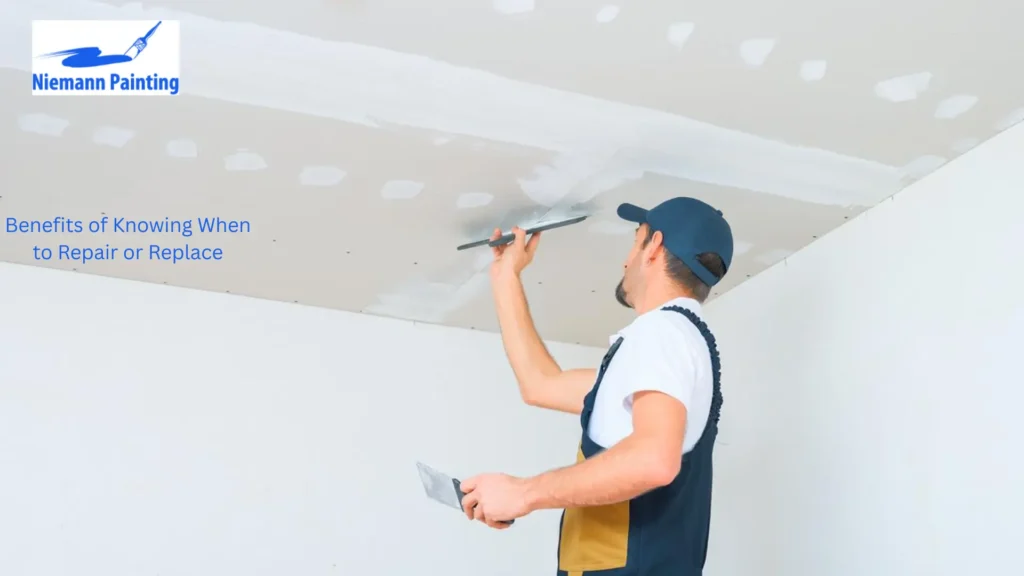Drywall is among the most significant components of the interior of your house. It makes your walls appear smooth and finished, and your home complete. However, similar to any other thing in a house, drywall may be damaged in the long run.
As a homeowner in Andover, you might have the question: do you repair the damage or do you put up new drywall? It is not always black and white. We will take you through the steps to make the right decision, what to watch out and when a professional should be called in this guide.
Why Drywall Problems Matter in Andover Homes
Drywall issues can be minor, such as a crack or a dent, but when they are neglected, they can become larger. Drywall is not only aesthetic, but also assists in keeping your home dry, unwelcoming of pests, and even of fire in some instances.
Andover homes are usually susceptible to special conditions such as humid summers and cold winters, and storms that cause water damage. These conditions can reduce the life of drywall in damp environments and ensure maintenance is more significant. It pays to know when it is best to repair and when it is best to replace, which will save you money and maintain your home in good condition.
Where Drywall Issues Commonly Show Up
Your home does not have the same risks in all its rooms. Issues that arise with drywall usually manifest in more humid or busier places.
- Bathrooms and basements: Bathrooms and basements are more vulnerable to high humidity.
- Kitchens: Soft spots may be caused by the spillage of steam and water.
- Living rooms and bedrooms: These are generally safe, but cracks could develop when the house settles.
- Garages: In this case, impact damage is more widespread because of heavy tools and storage.
With an understanding of where drywall problems occur most often, you will be able to monitor and provide an early response.
Repair or Replace? A Deep Look at Drywall Decisions
The decision on drywall repair or replacement may seem strenuous. On the one hand, a fast patch may be all you are required. On the other hand, complete replacement could save you the headaches in the future. Now, we can explore the depths of the method of determining whether to replace or do a quick fix to drywall.
Common Drywall Problems in Homes
There are a variety of types of drywall damage. These are the most frequent problems encountered by Andover homeowners:
- Minor dents and dings: These are normally left by the moving furniture or by accidental bumping.
- Nail pops: Small holes through which drywall screws have loosened with time.
- Cracks: These may be a result of settling of the foundation or seasonal. Such signs as leaks or excessive humidity.
- Soft or crumbling spots: They are usually an indication of water damage underneath the surface.
- Mold growth: This appears when drywall remains wet for an extended period of time.
All kinds of problems require a variety of approaches.
Drywall Patch vs Full Replacement
- Patch repairs: These are suitable when there are small holes, dents, or nail pops. They are fast, cheap, and they merge with the rest of the wall cleaning.
- Partial replacement: In case a part has been seriously damaged, you can use a razor to cut the affected part and replace only that section.
- Full replacement: Required in case of extensive damage, such as flood damage, significant mould, or structural problems.
- A good guideline: it is frequently wiser to replace a damaged portion of the wall when it is over 30-40 percent.
When Water Damage Means Drywall Replacement
Drywall replacement is caused mostly by water damage. When drywall is wet, it becomes weak and may begin to develop mould in under 24-48 hours.
Symptoms that are possible indicators of need:
- Pushing on the wall, it is soft or spongy.
- Dark spots or visible moulds are seen.
- The plaster or wall is cancelling out or dropping down.
- The damage continues to recur despite repairs.
In case of Andover homes, where heavy rainfalls and snowmelt may at times result in leaks, one of the most common causes of full-fledged replacement of drywall is water damage.
Drywall Repair vs Replacement Cost
The decision is frequently motivated by cost. Here’s a general breakdown:
- Patch repair: $50 to 2000 dollars depending on area and finish.
- Partical replacement: 200-500 per part.
- Complete replacement of room: $1,000 and above, based on room size and material.
Almost everything will be cheaper to repair in the short term, but replacement can save money in the long term in cases of severe damage. An estimate offered by a professional drywall repair contractor would provide you with a precise estimate after evaluating the damage.
Lifespan of Drywall in Humid Climates
Drywall under normal circumstances may last 30-70 years. However, in places with humid climates, such as Andover has during the summer, the life span may be significantly shorter when the drywall is not sealed or maintained. Moisture control: with dehumidifiers, ventilation and waterproof paint will help lengthen its lifespan.
Professional Drywall Repair Contractors vs DIY
Although there are homeowners who do small repairs by themselves, having a professional is a huge advantage:
- They are perfectly aligned with texture and paint.
- They can detect some hidden problems, such as leaks or molds.
- They complete tasks in less time with less mess.
- They ensure that repair is done to a safe and building standard.
In the event you are not comfortable with the tools, hiring the services of a professional drywall repair contractor is generally worth the money.
Benefits of Knowing When to Repair or Replace

Doing the right thing pays off in the long run on your house and pocket.
- Economize by not having to do full replacements.
- Reduce illness by preventing the proliferation of the moldy drywall by replacing.
- Enhance the house value by having smooth, no-damage walls.
- Avoid future troubles by fixing water or foundation problems at the earliest stage.
Tips for Maintaining Drywall in Andover Homes
To have drywall in good condition, prevention is the first step. Here are simple strategies:
- Keep moisture down: Use exhaust fans in kitchens and bathrooms.
- Repair leaks in a flash: Small drips may result in an expensive drywall repair.
- Look at cracks: Small cracks can indicate large structural problems.
- Paint good paint: Good protection is provided by a good primer and paint.
- Take care of the furniture: Do not bump the walls when moving big furniture.
These are some of the practices that can prolong the life of drywall and minimize expensive replacements.
FAQs
In case it is soft, crumbling, moldy, or disintegrated into huge chunks, it is better to replace it.
No, the replacement of water-damaged drywall should be done to prevent the development of mold.
Drywall has a lifespan of decades- even more than 50 years in dry conditions. Lifestyle is reduced in humid climates without taking proper care.
Repairing minor faults incurs low expenses, which are less than 200 dollars, whereas complete replacement is very expensive.
Yes, the small holes and cracks may be DIY; however, bigger ones should be assigned to the professionals.
Small spots are repaired with a patch, and extensive or serious damage will require replacement.
Conclusion
Home care is not necessarily the first thing that pops in your mind when you mention drywall, yet it has a significant role in the appearance and security of your home. To Andover homeowners, it matters when to repair and when to replace. Small dents and cracks are usually fixable, but water damage, mould or big areas of damage are usually the indicator of a replacement.
With a watchful eye of problem areas, managing moisture, and engaging the services of professional drywall repair contractors when necessary, you will be able to maintain the appearance of your home fresh and safe over the years.
To explore more home care, visit Neimann Painting.

